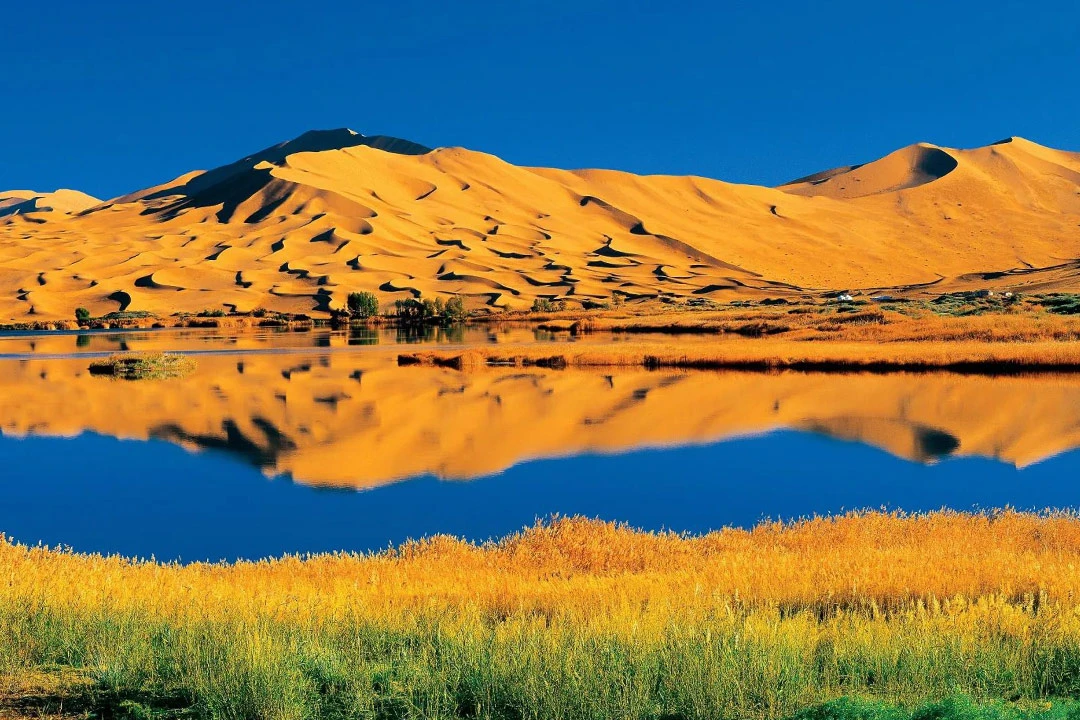On July 26, 2024, during the 46th session of the UNESCO World Heritage Committee held in New Delhi, India's capital, China's Badain Jaran Desert officially earned its place on the World Heritage List. This remarkable achievement underscores the desert's exceptional natural beauty and geological significance, making it one of the most extraordinary desert landscapes in the world. But what makes the Badain Jaran Desert so unique that it was able to secure a spot on this prestigious list? Let's explore the factors that set this desert apart from others and discover why it stands as a marvel of natural wonder.
Majestic Peaks and Shifting Sands: A Living Fossil of Desert Evolution
The Badain Jaran Desert, located in the western part of Inner Mongolia, is the third-largest desert in China and the second-largest shifting desert in the country. Unlike the barren, lifeless image that most people associate with deserts, the Badain Jaran is a dynamic landscape of towering sand dunes, mysterious lakes, and diverse ecosystems. Among its many impressive features is Bilutu Peak, the world's tallest stationary sand dune, standing at a staggering 460 meters high—earning it the title of the "Mount Everest of Sand Dunes."
What makes the Badain Jaran Desert truly fascinating is its role as a living fossil of desert evolution. The desert's sand formations, ranging from isolated dunes to interconnected dune chains, offer a vivid record of how desert landscapes develop over time. With more than 6,000 individual sand dunes, the desert presents an intricate tapestry of geological processes. These dunes are shaped by wind patterns that have persisted for millennia, creating a natural laboratory for studying the forces that sculpt desert landscapes.
One of the desert's most unique features is its vast singing sand area, the largest in the world. When the wind blows across the quartz sand grains, they resonate, creating a deep, humming sound that can be heard from miles away. This phenomenon, known as "singing sands," adds an eerie yet enchanting quality to the desert, making it a place of both scientific interest and natural beauty.
The Oasis Within: A Desert of Lakes
Perhaps the most astonishing aspect of the Badain Jaran Desert is the presence of over 140 lakes, scattered like jewels amidst the golden sands. These lakes, locally known as "haizi," vary in size, shape, and color, adding a surreal dimension to the desert's landscape. The largest of these is Badain Lake, a freshwater lake that lies nestled between sand dunes, creating a striking contrast between the barren desert and the lush, water-filled oasis.
The formation of these lakes is a subject of ongoing scientific study. Early theories suggested that the lakes were fed by underground water sources from nearby mountain ranges, but more recent research indicates a more complex origin. According to scholars like Ding Hongwei, the water that sustains these lakes may originate from the distant Qinghai-Tibet Plateau, carried through underground channels by regional groundwater flow systems. As this water travels northward, it is heated by geothermal activity, causing it to rise and form the lakes that dot the desert.
These lakes are not only a visual spectacle but also play a crucial role in sustaining the desert's unique ecosystems. The lakes provide a habitat for a variety of flora and fauna, including reeds, fish, and migratory birds. The diversity of life around these lakes is a testament to the resilience of nature, thriving even in the harshest environments.
One particularly fascinating lake is Dagetu Lake, known for its pink hue that changes with the seasons. In summer, the lake's vibrant pink color is due to the proliferation of halophilic microorganisms, while in autumn, the color shifts to a pale pink, caused by the crystallization of salts. This seasonal transformation adds yet another layer of wonder to the desert, making it a place of endless surprises.
The Unexpected Biodiversity of the Badain Jaran
The Badain Jaran Desert is not just a landscape of sand and lakes; it is also a thriving habitat for a wide range of species. The desert's unique combination of sand dunes, lakes, and vegetation creates a mosaic of microhabitats that support an array of wildlife. From the iconic Bactrian camels, often called the "ships of the desert," to lesser-known species like sand lizards, scorpions, and desert foxes, the Badain Jaran is teeming with life.
The desert's lakes serve as critical watering holes for these animals, attracting a diverse community of birds, mammals, and insects. The presence of water in such an arid environment has led to the development of a unique ecosystem, where species have adapted to the extreme conditions of the desert. For instance, the lakes are home to various fish species, while the surrounding vegetation provides cover for small mammals and reptiles.
The Badain Jaran Desert's rich biodiversity is a reflection of its complex ecological processes, where the interplay between sand, water, and life creates a delicate balance. Conservation efforts in the region have focused on preserving this unique environment, ensuring that the desert remains a sanctuary for its many inhabitants.
The Unrivaled Beauty of the Badain Jaran Desert
The inclusion of the Badain Jaran Desert on the World Heritage List is a recognition of its extraordinary natural beauty and ecological significance. From its towering sand dunes to its serene lakes and diverse wildlife, the Badain Jaran is a place that defies expectations and challenges our understanding of what a desert can be. As one of China's most beautiful deserts, it stands as a testament to the power of nature to create landscapes of unparalleled wonder and complexity.
For those seeking adventure, discovery, and a deeper connection with the natural world, the Badain Jaran Desert offers an experience like no other—a journey into the heart of a desert that is as alive and vibrant as any forest or mountain range.




